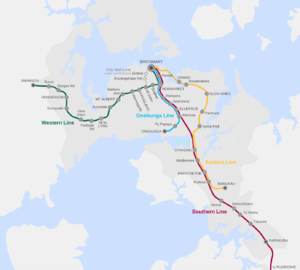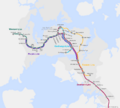City Rail Link facts for kids
Quick facts for kids City Rail Link |
|
|---|---|
 |
|
| Overview | |
| Status | Under construction |
| Owner | City Rail Link Limited (During construction) Auckland Transport (After completion) |
| Locale | Central Auckland, New Zealand |
| Termini | Britomart Transport Centre Mount Eden |
| Connecting lines | Western Line (Mt Eden) Southern, Onehunga, Eastern, Western (Britomart) |
| Stations | 4 |
| Website | cityraillink.co.nz |
| Service | |
| Type | Commuter rail/rapid transit |
| System | AT Metro |
| Operator(s) | Transdev Auckland |
| Rolling stock | AM Class |
| History | |
| Commenced | 2016 (Preliminary works) |
| Opened | 2024 (projected) |
| Technical | |
| Line length | 3.5 kilometres (2.2 mi) |
| Number of tracks | 2 |
| Character | Tunnel |
| Track gauge | 1,067 mm (3 ft 6 in) |
| Electrification | 25 kV AC overhead |
The City Rail Link (CRL) is a big train project happening right now in Auckland, New Zealand. It involves building a 3.5 kilometer (about 2.2 miles) long double-track tunnel under Auckland's city center. This tunnel will connect the Britomart Transport Centre and Mount Eden railway station.
The project will create two new underground stations: Aotea and Karangahape. Britomart will change from a station where trains stop at the end of the line to one where they can pass straight through. Mount Eden Station is also being rebuilt to connect the new CRL line with the existing Western Line.
Ideas for improving Auckland's train system have been around since the 1920s. In the early 2000s, more people started using trains, especially after Britomart opened in 2003. This made the City Rail Link idea popular again. The project is expected to cost about $4.4 billion and should be finished in 2024.
Contents
What are the benefits of the CRL?
The City Rail Link will bring many good changes for Auckland's train network:
- More trains: Britomart will become a "through" station. This means more than twice as many trains can pass through the city center. Trains could run every five minutes on existing lines.
- New stations: Two new stations in the city center will make it much easier to get around by train. This will help businesses and reduce traffic problems.
- Faster travel: Trips on the Western Line will be much quicker. Trains won't need to go around the city center anymore.
- Direct connections: Train lines from different parts of the city can connect directly through the tunnel. This creates easy cross-city routes.
- Future growth: The CRL will allow new train lines to be added later, like connections to Auckland Airport or the North Shore.
- Better access: The number of Aucklanders who can reach the city center by train in 30 minutes will double.
History of the City Rail Link
The idea for a city train tunnel is not new. People have been thinking about it for a long time.
Early ideas from the 1920s
Serious plans for a tunnel started in the 1920s. It was called the 'Morningside Tunnel' or 'Morningside Deviation'. In 1936, the Minister of Railways thought it would cost about £1 million. He wasn't sure if it would make money just from trains, but he knew it would have other benefits for the city.
1970s rapid train plans
In the 1970s, Auckland's mayor, Dove-Myer Robinson, proposed a big rapid transit system. It included a loop connecting to Newmarket and two main stations in the city center. A third station was planned for Karangahape Road. However, the government decided it was too expensive and rejected the plan in 1976.
Later, in 1979, another idea came up for an overhead railway. But this plan also didn't go ahead.
Train revival in the 2000s
After 2000, interest in trains grew again. In 2004, Auckland City Council made new plans for an underground railway. It would connect Britomart to the Western Line near Mount Eden. This plan included three new stations: near Aotea Square, Karangahape Road, and Symonds Street.
When Auckland's train network was electrified, the tunnel became a key next step. The estimated cost was around NZ$1.5 billion.
In 2008, planners agreed on a 3.5 km tunnel under Albert Street. It would have underground stations near Wellesley Street and Karangahape Road. The Wellesley Street station was expected to be very busy.
In 2009 and 2010, the tunnel project became a big topic for Auckland's mayoral elections. Both main candidates supported it. However, the national government was not keen on funding it at first. After a lot of effort from Mayor Len Brown, the project gained more support.
Planning and design in the 2010s
In 2010, a preferred route was chosen with three stations: Aotea, K Road (Karangahape), and Newton. The estimated cost was between $1 billion and $1.5 billion. The government still wasn't convinced it was a good idea. So, Auckland Council decided to pay for the planning and route protection work themselves.
In 2012, Auckland Council spent more money to continue planning. This included checking the ground, buildings, and train operations.
In 2013, the central government finally announced its support for the project. However, they wanted construction to start later, in 2020. They said they might start earlier if Auckland's city center grew faster.
A big change happened in 2014. The underground Newton Station was removed from the plans. Instead, Mount Eden station would be greatly upgraded. This saved over $150 million and allowed Mount Eden to connect directly to the CRL. The Mount Eden CRL platforms would be built in an open trench.
In January 2016, the Prime Minister confirmed that the central government would fund the main construction work. This meant Auckland Council could start building in 2018, with government money flowing from 2020.
City Rail Link Limited
In 2017, a new company called City Rail Link Limited (CRLL) was set up. This company is jointly owned by the central government and Auckland Council. Its job is to manage and deliver the City Rail Link project.
Platform changes for more passengers
The CRL was designed to carry 36,000 passengers per hour. This number was expected to be reached by 2045. But in 2018, new predictions showed that this capacity would be reached much sooner, by 2035.
To handle more people, the trains will need to be longer. This means the station platforms also need to be longer. The new plan is to make the platforms long enough for nine-car trains. This will increase the capacity to 54,000 passengers per hour. It also means building an extra entrance at Beresford Square for Karangahape Station right from the start. Making these changes now will prevent costly closures later.
How much does the CRL cost?
The cost of the City Rail Link has been a big discussion point. The estimated cost was first around $2.86 billion. This included the tunnel, three stations, new trains, and other improvements to the rail network.
In 2016, the cost was re-estimated to be between $2.8 and $3.4 billion. Then, in April 2019, it was announced that the cost had increased to $4.419 billion.
How will the CRL be built?
The City Rail Link will be built using two main methods:
- Cut-and-cover: This involves digging a trench from the surface, building the tunnel, and then covering it up again.
- Tunnel boring machine (TBM): This is a giant machine that drills through the ground to create the tunnels.
The ground varies from rock to soft soil. Cut-and-cover will be used near Mount Eden Station and in Eden Terrace. From there, two bored tunnels will go as far as Mayoral Drive. Another cut-and-cover section will go under Albert Street and then turn east, passing under the new Downtown Shopping Centre and into Britomart.
The TBM started drilling the first tunnel from Eden Terrace. Once it reaches Mayoral Drive, it will be taken apart and moved back to Eden Terrace to drill the second tunnel. In 2020, the TBM was named "Dame Whina Cooper" after a famous Māori leader.
The tunnels will mostly go through sandstone and siltstone. About 2 million tonnes of dirt will be dug out.
Some people living near Albert Street were worried about the construction. They thought it would cause traffic problems for about two years.
Construction progress
Construction started in October 2015 with early work between Britomart and Wyndham Street.
Two main groups of companies are building the CRL:
- The Downer joint venture is working on the tunnel under Britomart Station and Queen Street.
- The Connectus consortium is building the cut-and-cover tunnels under Albert Street. They started by moving a large stormwater pipe.
The Downtown Shopping Centre was closed in May 2016 and then demolished. A new skyscraper with a shopping center is being built there. The tunnels for the CRL are going directly underneath this new building.
In December 2020, Auckland's Mayor, Phil Goff, showed off the huge tunnel boring machine. It will drill two 1.6 km (about 1 mile) tunnels from central Auckland to Mount Eden Station.
Britomart Transport Centre
After the CRL is finished, Britomart will no longer be a dead-end station. Trains will be able to go straight through on platforms 5 and 1. Platforms 2, 3, and 4 will still be used for trains that end their journey there.
Aotea station
This station will be built using the cut-and-cover method. It will be about 15 meters (49 feet) deep under Albert Street. It will be around 300 meters (984 feet) long, stretching between Victoria Street and Wellesley Street.
Karangahape station
This station will be about 32 meters (105 feet) underground. It will have an entrance on Mercury Lane. Because more passengers are expected, the platforms are being made longer. An entrance at Beresford Square will also be built from the start.
Demolition of buildings for this station began in November 2019.
Mount Eden station
In October 2019, demolition of 30 buildings started near Mount Eden station. This was the first step in rebuilding the station area.
Public opinion
Many Aucklanders support the City Rail Link. A poll in June 2012 showed that 63% of people were in favor of the tunnel. Another poll in November found similar support at 64%. Only a small number of people were against it.
Most people who supported the project wanted it built as soon as possible. Many also thought the central government should pay a lot of the cost.
Images for kids



